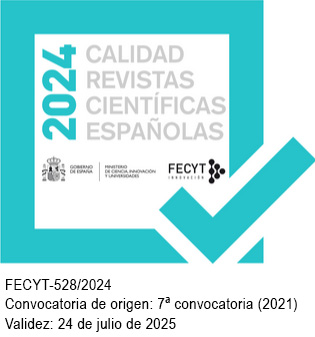Negation, Nominalizations and States
doi: https://doi.org/10.31810/rsel.55.1.5
Keywords:
negación; nominalizaciones deverbales; aspecto léxico; estadosAbstract
The main goal pursued in this article consists in analysing the interaction of the negative particle no with those Spanish nouns that denote a state. Firstly, those nominals which possess a nominalizer are addressed. We show that they accept being preceded by no and we describe the interpretation that arises with them in this case. Then, whether negation modifies the aspectual properties of this class of nominals is studied. Next, we provide an explanation for the behaviour of these nominalizations which is based on the interaction of negation with their structural configuration. Secondly, those nouns that lack a nominalizer are scrutinised. It is concluded that they reject co-occurring with no, and that, depending on their syntactic structure, this incompatibility can arise from the interruption of the constituent by negation or from their non-possession of verbal nodes.
Downloads
References
Alexiadou, A. (2001). Functional structure in nominals. Nominalization and ergativity. John Benjamins.
Alexiadou, A. (2011). Statives and nominalizations. Recherches linguistiques de Vincennes, 40, 25-52.
Aleixadou, A. & Grimshaw, J. (2008). Verbs, nouns and affixation. In F. Schäfer (Ed.). Working Papers of the SFB 732 «Incremental Specification in Context» 01 (pp. 1-16).
Arad, M. (1999). What counts as class? The case of psych verbs. MIT Working papers in linguistics 35: Papers from the UPenn/MIT roundtable on the lexicon, 1-23.
Asher, N. (1993). Reference to abstract objects in discourse. Kluwer Academic Publisher.
Bach, E. (1986). The algebra of events. Linguistics and Philosophy, 9, 5-16.
Belletti, A. & Rizzi, L. (1988). Psych verbs and θ-theory. Natural Language & Linguistic Theory, 6, 291-352.
Bennett, M. & Partee, B. H. (1972). Toward the logic of tense and aspect in English. In B. H. Partee (Comp.). Compositionality in formal semantics. Selected papers by Barbara H. Partee (pp. 59-109). Wiley Blackwell.
Bernard, T. & Champollion, L. (2023). Negative events and compositional semantics. Journal of Semantics, 40(4), 585-620.
Bertinetto, P. M. (1986). Tempo, aspetto e azione nel verbo italiano. Il sistema dell’indicativo. Accademia della Crusca.
Borer, H. (2013). Structuring sense, volume 3: Taking form. Oxford University Press.
Caha, P. (2009). The nanosyntax of case. [Doctoral dissertation, University of Tromsø].
Cooper, R. (1998). Austinian propositions, Davidsonian events and perception complements. In J. Ginzburg, Z. Khasidashvili, C. Vogel, J.-J- Levy & E. Vallduví (Eds.). The Tbilisi symposium on language, logic and computation: Selected papers (pp. 19-34). CSLI Publications.
Corbett, G. G. (1991). Gender. Cambridge University Press.
de Miguel, E. (1999). El aspecto léxico. En I. Bosque & V. Demonte (Dirs.). Gramática descriptiva de la lengua española, vol. 2 (pp. 2977-3060). Espasa Calpe.
de Swart, H. (1993). Adverbs of quantification: A generalized quantified approach. Garland Press.
de Swart, H. (1996). Meaning and use of not… until… Journal of Semantics, 13(3), 221-263.
de Swart, H. y Molendijk, A. (1999). Negation and the temporal structure of narrative discourse. Journal of Semantics, 16(1), 1-42.
Dowty, D. R. (1979). World meaning and Montague grammar: The semantics of verbs and times in generative semantics and in Montague’s PTQ. Reidel.
Fábregas, A. (2014). Argument structure and morphologically underived nouns in Spanish and English. Lingua, 141, 97-120.
Fábregas, A. (2016). Las nominalizaciones. Visor Libros.
Fábregas, A. (2018). Word order and nanosyntax. Preverbal subjects and interrogatives across Spanish varieties. In L. Baunaz, L. Haegeman, K. De Clercq & E. Lander (Eds.). Exploring Nanosyntax (pp. 250-277). Oxford University Press.
Fábregas, A. & González Rodríguez, R. (2020). On inhibited eventualities. Natural Language & Linguistic Theory, 38(3), 729-773.
Fábregas, A. & Marín, R. (2012a). Differenciating eventivity from dynamicity: The Aktionsart of Davidsonian state verbs. Linguistic Symposium on Romance Languages 42 (pp. 1-14). Southern Utah University.
Fábregas, A. & Marín, R. (2012b). State nouns are Kimian states. In I. Franco, S. Lusini & A. Saab (Eds.). Romance languages and linguistic theory 2010. Selected paperes from ‘Going Romance’ Leiden 2010 (pp. 41-64). John Benjamins.
Fábregas, A. & Marín, R. (2012c). The role of Aktionsart in deverbal nouns: State nominalizations across languages. Journal of Linguistics, 48(1), 35-70.
Fábregas, A. & Marín, R. (2015). Deriving individual-level and stage-level psych verbs in Spanish. The linguistic Review, 32(2), 167-215.
Fábregas, A., Marín, R. & McNally, L. (2012). From psych verbs to nouns. In V. Demonte & L. McNally (Eds.). Telicity, change and state: A cross-categorial view of event structure (pp. 162-184). Oxford University Press.
Felser, C. (1999). Verbal complement clauses: A minimalist study of direct perception constructions. John Benjamins.
Fradin, B. (2011). Remarks on state denoting nominalizations. Recherches linguistiques de Vincennes, 40, 73-99.
García Fernández, L. (2000). La gramática de los complementos temporales. Visor Libros.
García-Pardo, A. (2020). Stative inquiries: Causes, results, experiencers and locations. John Benjamins.
González Rodríguez, R. (2009). La expresión de la afirmación y la negación. Arco/Libros.
Grimshaw, J. (1990). Argument structure. The MIT Press.
Harris, J. W. (1991). The exponence of gender in Spanish. Linguistic Inquiry, 22(1), 22-67.
Higginbotham, J. (1983). The logic of perceptual reports: An extensional alternative to situation semantics. Journal of Philosophy, 80(2), 100-127.
Higginbotham, J. (2000). On events in linguistic semantics. In J. Higginbotham, F. Pianesi & A. C. Varzi (Eds.). Speaking of events (pp. 49-79). Oxford University Press.
Horn, L. R. (1989). A natural history of negation. CSLI Publications.
Husband, M. (2010). On the compositional nature of stativity. [Doctoral dissertation, Michigan State University].
Iordăchioaia, G. (2020). Categorization and nominalization in zero nominals. In A. Alexiadou & H. Borer (Eds.). Nominalization: 50 years on from Chomsky’s Remarks (pp. 231-253). Oxford University Press.
Jaque, M. (2014). La expresión de la estatividad en español: niveles de representación y grados de dinamicidad. [Doctoral dissertation, Universidad Autónoma de Madrid].
Kratzer, A. (1996). Severing the external argument from its verb. In J. Rooryck & L. Zaring (Eds.), Phrase structure and the lexicon (pp. 109-137). Springer.
Krifka, M. (1989). Nominal reference, temporal constitution and quantification in event semantics. In R. Bartsch, J. van Benthem & P. van Emde Boas (Eds.). Semantics and contextual expressions (pp. 75-115). Kluwer.
Lakoff, G. (1965). Irregularity in syntax. Holt, Reinhart & Winston.
Lang, M. F. (1990). Formación de palabras en español. Morfología derivativa productiva en el léxico moderno. Cátedra.
Maienborn, C. (2003). Die logische Form von Kopula-Sätzen. Akademie Verlag.
Maienborn, C. (2005). On the limits of the Davidsonian approach: The case of copula sentences. Theoretical Linguistics, 31(3), 275-316.
Maienborn, C. (2007). On Davidsonian and Kimian states. In I. Comorwsky & K. von Heusinger (Eds.). Existence: Semantics and syntax (pp. 107-170). Springer.
Marín, R. (2011). Casi todos los predicados psicológicos son estativos. En Á. Carrasco Gutiérrez (Ed.). Sobre estados y estatividad (pp. 26-44). Lincom Europa.
Marín, R. (2022). Los mejores diagnósticos sobre estados reunidos. Borealis: An international journal of Hispanic linguistics, 11(3), 229-246.
Marín, R. & McNally, L. (2011). Inchoativity, change of state and telicity: Evidence from Spanish reflexive psychological verbs. Natural Language & Linguistic Theory, 29(2), 467-502.
Meinschäfer, J. (2003). Nominalizations of French psychological verbs. In J. Quer, J. Schroten, M. Scoretti, P. Sleeman & E. Verheugd-Daatzelaar (Eds.). Romance languages and linguistic theory 2001: Selected papers from ‘Going Romance’, Amsterdam 6-8 December 2001 (pp. 231-246). John Benjamins.
Meinschäfer, J. (2005). Deverbal nouns in Spanish. Lingue e Linguaggio, 4(2), 215-218.
Oltra-Massuet, I. (1999). On the constituent structure of Catalan verbs. MIT Working papers in linguistics, 33, 279-322.
Pantcheva, M. (2011). Decomposing Path. The nanosyntax of directional expressions. [Doctoral dissertation, University of Tromsø].
Picallo, C. (1991). Nominals and nominalizations in Catalan. Probus, 3(3), 279-316.
Picallo, C. (2008). Gender and number in Romance. Lingue e Linguaggio, 7, 47-66.
Przepiórkowski, A. (1999). On negative eventualities, negative concord and negative yes/no questions. In T. Matthews & D. Strolovitch (Eds.). Proceedings of Semantics and Linguistic Theory 9 (pp. 237-254). CLC Publications.
Pylkkännen, L. (2000). On stativity and causation. In C. Tenny & J. Pustejovsky (Eds.). Events as grammatical objects: The converging perspectives of lexical semantics and syntax (pp. 417-442). CSLI Publications.
RAE-ASALE = Real Academia Española & Asociación de Academias de la Lengua Española (2009). Nueva gramática de la lengua española. Espasa-Calpe.
Ramchand, G. C. (2008). Verb meaning and the lexicon: A first phase syntax. Cambridge University Press.
Ros García, L. (2023). La negación de las nominalizaciones deverbales. Verba, 50, 1-26.
Ros García, L. (2024). A syntactic analysis of in Spanish. The Linguistic Review, 41(2), 287-337.
Rothmayr, A. (2009). The structure of stative verbs. John Benjamins.
Sánchez López, C. (1999). La negación. En I. Bosque & V. Demonte (Dirs.). Gramática descriptiva de la lengua española, vol. 2 (pp. 2561-2634). Espasa-Calpe.
Seco, M. (1964). Diccionario de dudas y dificultades de la lengua Española. Aguilar.
Sleeman, P. & Brito, A. M. (2010). Nominalization, event, aspect, and argument structure: A syntactic approach. In M. Duguine, S. Huidobro & N. Madariaga (Eds.). Argument structure from a crosslinguistic perspective (pp. 113-130). John Benjamins.
Starke, M. (2009). Nanosyntax. A short primer to a new approach to language. In P. Svenonious, G. Ramchand, M. Starke & K. T. Taraldsen (Eds.), Nordlyd 36-1. Special issue on Nanosyntax (pp. 1-6). Septentrio Press.
Stockwell, R. P., Schachter, P. & Partee, B. H. (1973). The major syntactic structures of English. Holt, Rinehart & Winston.
Taylor, B. (1977). Tense and continuity. Linguistics and Philosophy, 1(2), 199-220.
Travis, L. (1984). Parameters and effects of word order variation. [Doctoral dissertation, Massachusetts Institute of Technology].
van Voorst, J. (1992). The aspectual semantics of psychological verbs. Linguistics & Philosophy, 15, 65-92.
Published
How to Cite
Issue
Section
Copyright (c) 2025 Revista Española de Lingüística

This work is licensed under a Creative Commons Attribution-NonCommercial-NoDerivatives 4.0 International License.










